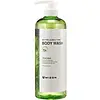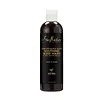What's inside
What's inside
 Key Ingredients
Key Ingredients

No key ingredients
 Benefits
Benefits

 Concerns
Concerns

 Ingredients Side-by-side
Ingredients Side-by-side

Water
Skin ConditioningSodium Laureth Sulfate
CleansingAmmonium Lauryl Sulfate
CleansingCocamidopropyl Betaine
CleansingCocamide Mea
EmulsifyingButylene Glycol
HumectantMelaleuca Alternifolia Leaf Extract
PerfumingRose Extract
Skin ConditioningLavandula Angustifolia Extract
Skin ConditioningCalendula Officinalis Extract
Skin ConditioningBombyx Mori Extract
Skin ConditioningZanthoxylum Piperitum Fruit Extract
Skin ConditioningHydrolyzed Sesame Extract
Skin ConditioningTurtle Extract
EmollientBarm Extract
Skin ConditioningGlycine Soja Extract
Skin ConditioningEel Extract
HumectantRibes Nigrum Seed Extract
EmollientOryza Sativa Extract
AbsorbentLimus Extract
Skin ConditioningGlycerin
HumectantSodium Chloride
MaskingCitric Acid
BufferingPolyquaternium-10
Coconut Acid
CleansingPhenoxyethanol
PreservativeDisodium EDTA
1,2-Hexanediol
Skin ConditioningLauryl Alcohol
EmollientAmmonium Sulfate
Sodium Benzoate
MaskingLaureth-2
CleansingSodium Sulfate
Aroma
Linalool
PerfumingWater, Sodium Laureth Sulfate, Ammonium Lauryl Sulfate, Cocamidopropyl Betaine, Cocamide Mea, Butylene Glycol, Melaleuca Alternifolia Leaf Extract, Rose Extract, Lavandula Angustifolia Extract, Calendula Officinalis Extract, Bombyx Mori Extract, Zanthoxylum Piperitum Fruit Extract, Hydrolyzed Sesame Extract, Turtle Extract, Barm Extract, Glycine Soja Extract, Eel Extract, Ribes Nigrum Seed Extract, Oryza Sativa Extract, Limus Extract, Glycerin, Sodium Chloride, Citric Acid, Polyquaternium-10, Coconut Acid, Phenoxyethanol, Disodium EDTA, 1,2-Hexanediol, Lauryl Alcohol, Ammonium Sulfate, Sodium Benzoate, Laureth-2, Sodium Sulfate, Aroma, Linalool
Water
Skin ConditioningAloe Barbadensis Leaf Juice
Skin ConditioningSodium Lauroyl Methyl Isethionate
CleansingCocamidopropyl Betaine
CleansingGlycerin
HumectantParfum
MaskingTocopherol
AntioxidantGlycine Soja Oil
EmollientCocos Nucifera Oil
MaskingElaeis Guineensis Kernel Oil
EmollientButyrospermum Parkii Butter
Skin ConditioningAvena Sativa Kernel Extract
AbrasiveTheobroma Cacao Husk
AbrasiveJojoba Esters
EmollientCI 77499
Cosmetic ColorantGuar Hydroxypropyltrimonium Chloride
Skin ConditioningCaramel
Cosmetic ColorantTrisodium Ethylenediamine Disuccinate
Sodium Chloride
MaskingSodium Benzoate
MaskingTriethyl Citrate
MaskingCaprylyl Glycol
EmollientBenzoic Acid
MaskingWater, Aloe Barbadensis Leaf Juice, Sodium Lauroyl Methyl Isethionate, Cocamidopropyl Betaine, Glycerin, Parfum, Tocopherol, Glycine Soja Oil, Cocos Nucifera Oil, Elaeis Guineensis Kernel Oil, Butyrospermum Parkii Butter, Avena Sativa Kernel Extract, Theobroma Cacao Husk, Jojoba Esters, CI 77499, Guar Hydroxypropyltrimonium Chloride, Caramel, Trisodium Ethylenediamine Disuccinate, Sodium Chloride, Sodium Benzoate, Triethyl Citrate, Caprylyl Glycol, Benzoic Acid
 Reviews
Reviews

Ingredients Explained
These ingredients are found in both products.
Ingredients higher up in an ingredient list are typically present in a larger amount.
Cocamidopropyl Betaine is a fatty acid created by mixing similar compounds in coconut oil and dimethylaminopropylamine, a compound with two amino groups.
This ingredient is a surfactant and cleanser. It helps gather the dirt, pollutants, and other impurities in your skin to be washed away. It also helps thicken a product and make the texture more creamy.
Being created from coconut oil means Cocamidopropyl Betaine is hydrating for the skin.
While Cocamidopropyl Betaine was believed to be an allergen, a study from 2012 disproved this. It found two compounds in unpure Cocamidopropyl Betaine to be the irritants: aminoamide and 3-dimethylaminopropylamine. High-grade and pure Cocamidopropyl Betaine did not induce allergic reactions during this study.
Learn more about Cocamidopropyl BetaineGlycerin is already naturally found in your skin. It helps moisturize and protect your skin.
A study from 2016 found glycerin to be more effective as a humectant than AHAs and hyaluronic acid.
As a humectant, it helps the skin stay hydrated by pulling moisture to your skin. The low molecular weight of glycerin allows it to pull moisture into the deeper layers of your skin.
Hydrated skin improves your skin barrier; Your skin barrier helps protect against irritants and bacteria.
Glycerin has also been found to have antimicrobial and antiviral properties. Due to these properties, glycerin is often used in wound and burn treatments.
In cosmetics, glycerin is usually derived from plants such as soybean or palm. However, it can also be sourced from animals, such as tallow or animal fat.
This ingredient is organic, colorless, odorless, and non-toxic.
Glycerin is the name for this ingredient in American English. British English uses Glycerol/Glycerine.
Learn more about GlycerinSodium Benzoate is a preservative. It's used in both cosmetic and food products to inhibit the growth of mold and bacteria. It is typically produced synthetically.
Both the US FDA and EU Health Committee have approved the use of sodium benzoate. In the US, levels of 0.1% (of the total product) are allowed.
Sodium benzoate works as a preservative by inhibiting the growth of bacteria inside of cells. It prevents the cell from fermenting a type of sugar using an enzyme called phosphofructokinase.
It is the salt of benzoic acid. Foods containing sodium benzoate include soda, salad dressings, condiments, fruit juices, wines, and snack foods.
Studies for using ascorbic acid and sodium benzoate in cosmetics are lacking, especially in skincare routines with multiple steps.
We always recommend speaking with a professional, such as a dermatologist, if you have any concerns.
Learn more about Sodium BenzoateChances are, you eat sodium chloride every day. Sodium Chloride is also known as table salt.
This ingredient has many purposes in skincare: thickener, emulsifier, and exfoliator.
You'll most likely find this ingredient in cleansers where it is used to create a gel-like texture. As an emulsifier, it also prevents ingredients from separating.
There is much debate on whether this ingredient is comedogenic. The short answer - comedogenic ratings don't tell the whole story. Learn more about comegodenic ratings here.
The concensus about this ingredient causing acne seems to be divided. Research is needed to understand if this ingredient does cause acne.
Scrubs may use salt as the primary exfoliating ingredient.
Learn more about Sodium ChlorideWater. It's the most common cosmetic ingredient of all. You'll usually see it at the top of ingredient lists, meaning that it makes up the largest part of the product.
So why is it so popular? Water most often acts as a solvent - this means that it helps dissolve other ingredients into the formulation.
You'll also recognize water as that liquid we all need to stay alive. If you see this, drink a glass of water. Stay hydrated!
Learn more about Water